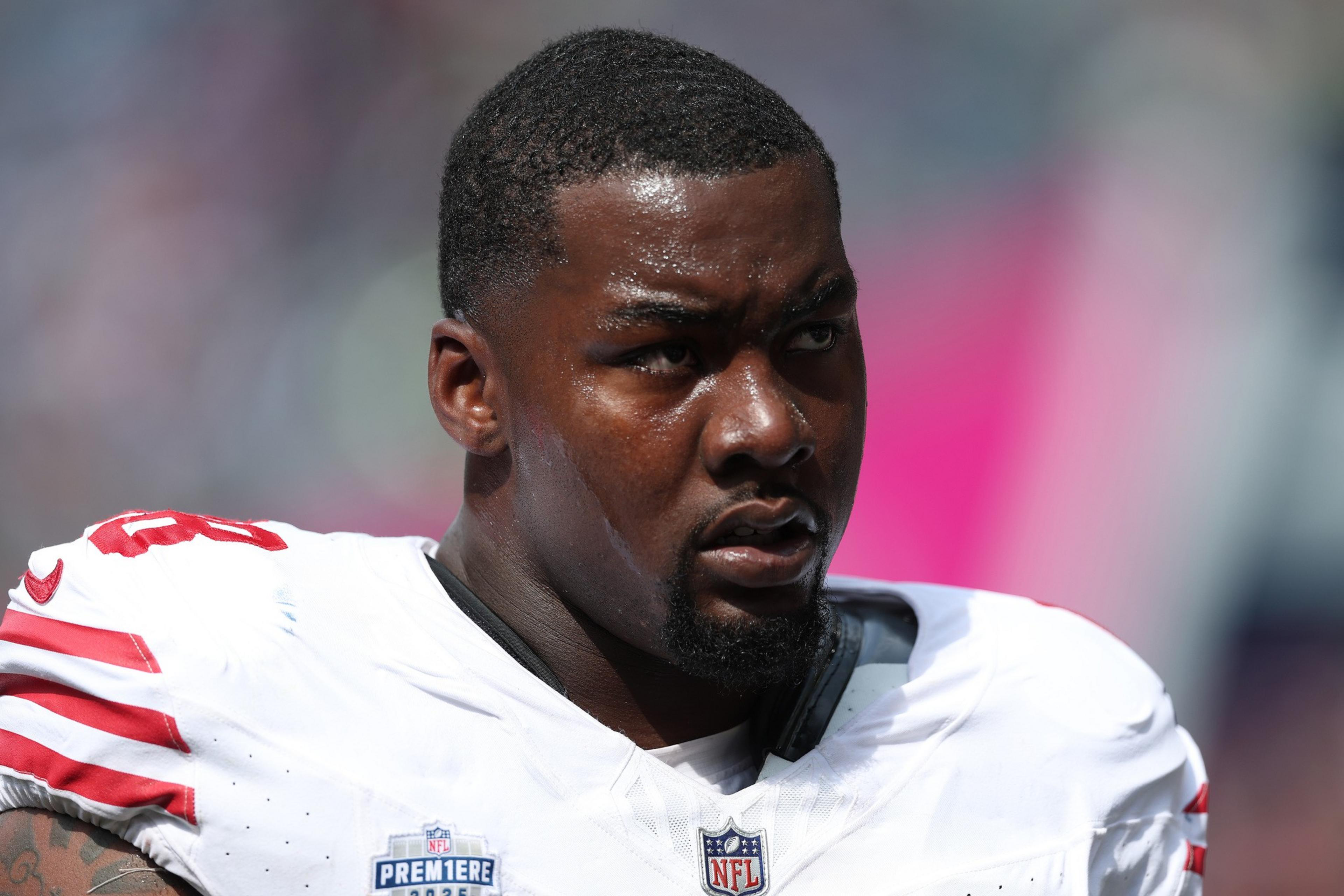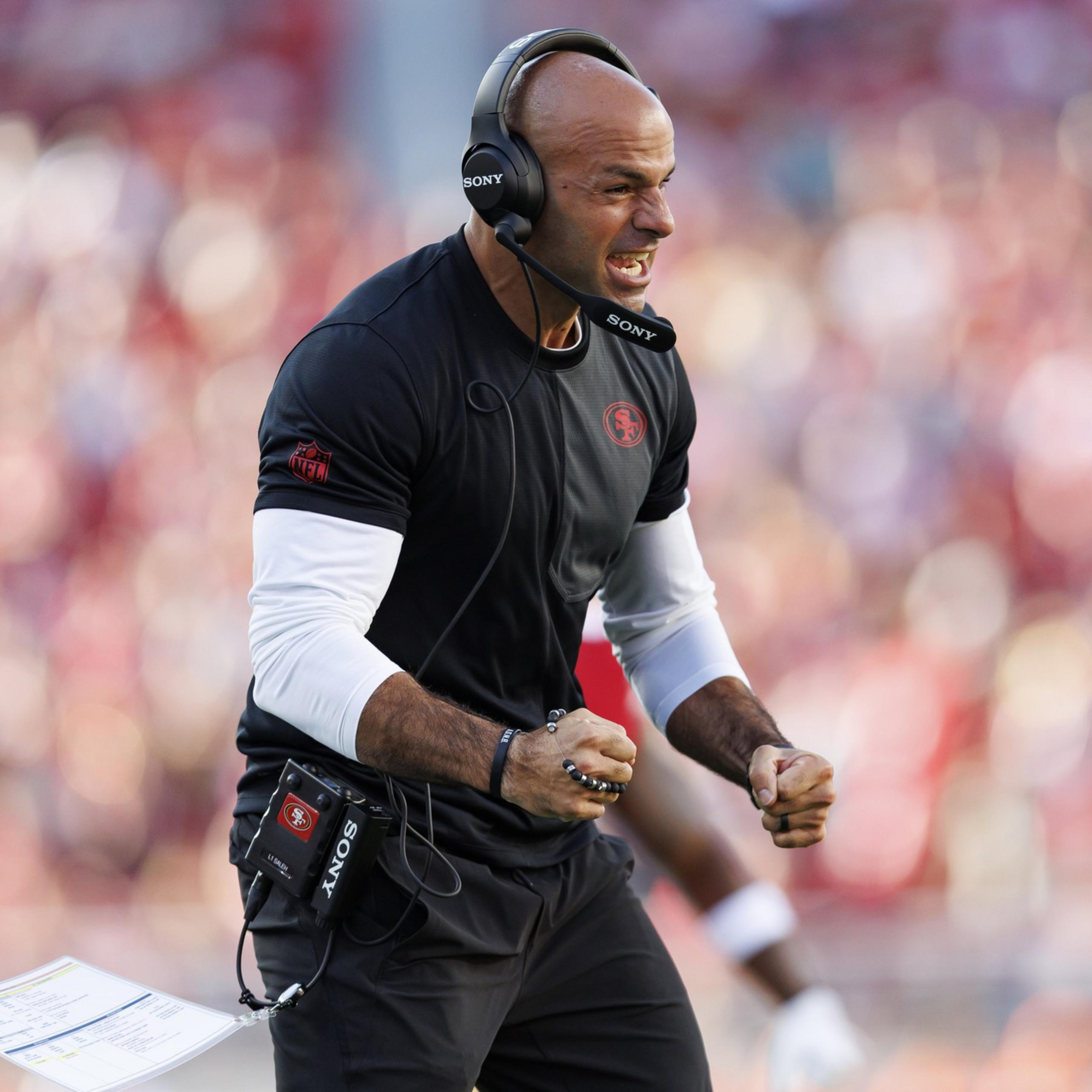Want more ways to catch up on the latest in Bay Area sports? Sign up for the Section 415 email newsletter here and subscribe to the Section 415 podcast wherever you listen.
Kyle Shanahan seemed genuinely curious (opens in new tab) in the exuberant 49ers locker room after they’d shocked the Los Angeles Rams.
“Who stopped that dude?” the coach yelled to his team, referring to the fourth-down stonewalling that had sealed the victory.
More than one 49er shouted the same response.
“All of us!”
They didn’t mean it as some platitude about teamwork. They meant it literally. A full host of 49ers defenders met L.A. running back Kyren Williams behind the line of scrimmage. With the whole night on the line, each executed his distinct role to perfection.
Rookie Alfred Collins clogged the A-gap, funneling the play to the right. His young teammate Mykel Williams wrecked shop in a specific direction too. Superstar linebacker Fred Warner’s strategy was to muddy the waters with reckless abandon, and he executed it well. Nickelback Chase Lucas took sage directional advice from safety Jason Pinnock and gambled on the C-gap, blasting blockers backward. Rookie Marques Sigle and vet Deommodore Lenoir finished off the play, freezing the Rams’ running back before dragging him backward.
The play, which immediately qualified as one of the more dramatic stands in the franchise’s regular-season history, was perfectly representative of how this 49ers defense has been succeeding.
Coordinator Robert Saleh’s unit is not overpowering — nor was it expected to be. They rank No. 14 in expected points added (EPA) per play; No. 8 against the run, and No. 22 versus the pass. They’re shorthanded, especially up front. But the unit is delivering in the highest-leverage moments, and — in true eyebrow-raising fashion — its production has been greater than the sum of its parts.
A statistical example: The 49ers rank as a top-3 run defense in short-yardage situations (opens in new tab). They put that on stunning display against the Rams twice: On the aforementioned fourth-down stop and on Collins’ forced fumble at the 1-yard line toward the end of regulation.
Both plays were an even bigger deal considering the 49ers’ incompetence stopping the run over the previous two seasons. This improvement is highlighted on the table below, which shows EPA ranks for each phase of defense through the years.
The 49ers’ defense has improved from No. 29 in 2024 to No. 8 this season against the run. Clearly, the rehiring of Saleh and the aggressive offseason renovation of the defense has this unit headed in the right direction.
But it hasn’t been a linear path — and that makes this defense’s development all the more fascinating. Let’s take a position-by-position look at the numbers, starting with a defensive line that’s in a world of hurt — but somehow managing to do just enough to get the job done.
Percentile scores of Pro Football Focus’ pass-rush productivity (which tallies sacks, pressures, and QB hits) and run-blocking grade are listed below, with defensive ends listed in the top half of the table and tackles in the bottom half. Above-average percentiles are in blue; below-average ones are red.
With Nick Bosa (done for the season with an ACL tear) and Yetur Gross-Matos (likely to miss multiple games with a hamstring injury) both out, it’s easy to see how depleted the 49ers are here and why they seem to be prime candidates to make moves — even relatively small ones — for D-linemen ahead of the Nov. 4 trade deadline.
Put bluntly, there’s an uncomfortable amount of dark red on the table above.
Some good news did trickle in Wednesday. Vet defensive tackle Kevin Givens, who tore his pectoral muscle in training camp, returned to practice. So did DT Kalia Davis, who broke his hand against the Rams but is wearing a club to protect surgical repairs. So the 49ers may be better suited than expected this week to weather the storm along the interior.
It also must be acknowledged that Bryce Huff is playing solid all-around ball and that rookie Mykel Williams seems to be making a bigger positive impact than PFF’s grades credit him for. Shanahan and Saleh have praised Williams, even though they didn’t expect him to light up the stat sheet as a rookie, for setting firm edges in the run game — especially against tight ends — and have credited that as a key to the 49ers’ improved run defense.
Williams was certainly a huge factor in that now-famous fourth-down stop against the Rams. Next, we’ll see if the 49ers do indeed acquire some pass-rushing help over the next month. That can be how the team best facilitates a gradual blossoming of consistency from its rookies, who are already delivering clutch plays.

A key for the numbers above: “TKL” tallies total tackles, “MTKL%” is missed tackle percentage, and “RTG” is the passer rating a player has allowed on throws into his coverage.
You’ll notice that there’s a lot more blue in the grade and performance columns of the back seven than there is on the D-line table.
Fred Warner is PFF’s highest-graded player, regardless of position. There is not a discernible weakness in his game. Ultimately, the strength of the 49ers’ linebackers will be determined by the less consistent variable, Dee Winters. He graded well in the first two games before struggling over the most recent three, allowing nine catches into his coverage against the Rams.
It’s fair to say that the cornerbacks have been the strength of Saleh’s defense so far. All ohave allowed a below-average passer rating into their coverage — even the rookie Upton Stout, who might’ve been robbed of an interception by a dubious penalty flag in Week 4. A pick would’ve made Stout’s number in that column even better.
Yes, it sounds odd to say that cornerbacks have led the way for a defense that’s ranked No. 22 in EPA/play against the pass and on a historically long interception drought. The 49ers are the first team since 1932 to go 12 straight games without a pick.
But although some penalties against corners have hurt the 49ers, their coverage allowances have all been good, and it does seem that the blame for the interception drought might be better placed on the 49ers’ struggling pass rush — and maybe on the team’s safeties, who have allowed most of the receiving damage into their coverage.
The return of Malik Mustapha, who said Wednesday in the locker room that he plans to play Sunday against the Tampa Bay Buccaneers, looms large here. While Sigle has flashed against the run, he’s given up 282 receiving yards into his coverage — the most of any NFL safety so far this season.
Mustapha was on the opposite end of the spectrum in 2024. He led all DBs with just 0.12 yards per cover snap allowed as a rookie.
The 49ers can use some help as soon as possible, as Tampa Bay presents a formidable challenge. Quarterback Baker Mayfield’s pass attack ranks No. 7 in EPA/play and is fresh off of playing the lead role in a 38-35 shootout win over the Seattle Seahawks.
The 49ers still won’t be close to full strength offensively. They’ll again ask their defense to clutch up.
The 49ers are underdogs, so there are more odds to defy. This statistical story is meant to illustrate how the team has overcome them so far, but there will certainly be more to explain as this defense evolves during the second quarter of the season.
This much is apparent: Saleh’s unit has made a lot of progress, but it doesn’t seem to be anywhere near its final form.




